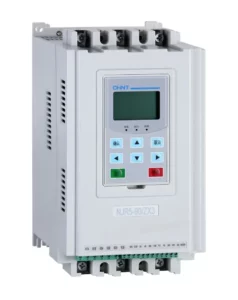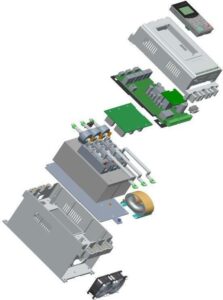Table of Contents |
A soft starter is an extremely useful device for controlling the start-up of electric motors. It controls voltage rise at the motor terminals and allows electric motors to gradually reach full speed. This means there’s reduced electrical current draw and torque spikes when powered on. Electric motors that use soft starters experience less mechanical stress and last longer as a result.
Main Purposes of Using Soft Starters
Motor starters are used to protect electric motors from high inrush currents and control motor starting torque for safety.
Limit Inrush Current
An induction motor at a standstill has low rotor impedance. This can lead to an inrush current that may damage the motor. Soft starters can limit these high inrush currents. They work by gradually increasing the voltage supplied to the motor. This prevents current spikes that could overheat motor windings or trip circuit breakers.
Control Starting Torque
Maximum starting torque can pose mechanical hazards to electric motors. The instant high torque can shock connected machinery. By limiting the current, a motor soft starter can indirectly reduce the starting torque to safer levels. This prevents damage from jerkiness at motor starts and ensures loads experience a gentler ride into full rotational speed.
How a Soft Starter Controls Voltage and Limits Inrush Current
A motor soft starter controls voltage and limits inrush current by utilizing thyristors and microcontroller control. Thyristors are connected within a motor starter in a parallel configuration. This allows the soft motor starter to introduce controlled resistance into the motor circuit on startup. By regulating the thyristors, the soft starter facilitates a controlled ramp-up of the voltage supplied to the motor terminals.
This staged approach prevents a sudden full voltage application that could cause a large spike in the current draw. Instead, the microcontroller slowly ramps up the voltage over several seconds. Through precise thyristor firing regulation, the soft starter smoothly brings the motor up to operating speed while avoiding damaging current surges.
Which Soft Starter Should You Choose?
The CHINT NJR5-ZX Online Soft Starter can be a good choice. This 3 phase motor starter is an online soft starter suitable for varied voltages and currents. With “online” operation, this product differs from traditional bypass contactor soft starters. Once it starts the motor, it continues working, unlike traditional bypass contactor soft starters that switch off once the motor is up to speed. This provides continuous soft control. Its other advantages include:
1. Wide Adaptability
Supporting voltages from 220V to 690V, currents from 15A to 1000A, and power ratings from 4KW to 900KW, the NJR5-ZX covers all needs in one product. This is suitable for diverse equipment needs like in mines where devices operate at different voltages. You don’t need to source from multiple brands.
2. More Precise Fault Diagnosis
Unlike similar products from competitors that display basic information only, e.g., overcurrent and overvoltage faults, the NJR5-ZX from CHINT additionally provides current, temperature, and voltage details at the fault time. This aids root cause analysis, allowing operators to quickly identify issues.
3. Savings in Wiring and Space
Requiring just six connecting wires (three inputs and three outputs) versus nine for traditional bypass starters, the NJR5-ZX simplifies installation work. Fewer connection points also reduce the risk of faults from poor joints or breaks over time.
Applications of Soft Starters
Soft starters offer smooth starts to protect equipment in key operations. Top applications include:
1. Compressor
The high starting torque of compressor motors can cause problems. Motor starters help compressors avoid power losses or failures from sudden electrical demands.
2. Fan
Fans requiring constant/fixed rotational speed benefit from soft starter current control, preventing shock loads from affecting ducts or structures.
3. Water Pump
Pump motors pushing significant volumes of water or chemical flows need soft acceleration to prevent water hammer effects in piping.
4. Crusher
The jerky starts of crusher drives without phase control could damage the crusher or connected conveyors. Soft starters ensure smooth operation.
5. Ball Mill
Rotating cylinders mixing heavy materials, ball mill drives demand careful current limitation via soft starters to prevent component weaknesses from torque spikes.
It should be noted that soft starters are well-suited for applications where motors must operate at a fixed rotational speed. For operations requiring adjustable motor speeds, a variable frequency drive provides greater control flexibility compared to a motor soft starter.
Conclusion
In summary, soft starters provide gentle acceleration for motors to reduce physical stresses. At CHINT, the NJR5-ZX online soft starter offers robust performance for a variety of voltages and currents in a compact package. Different from traditional bypass contactor starters, its online design means once it starts the motor, it continues working without requiring a separate contactor to engage at full speed. Its wide adaptability, precise fault diagnosis, and wiring space savings make it a comprehensive solution. Visit our website for more details on the specifications of this product and browse more of our offerings.














